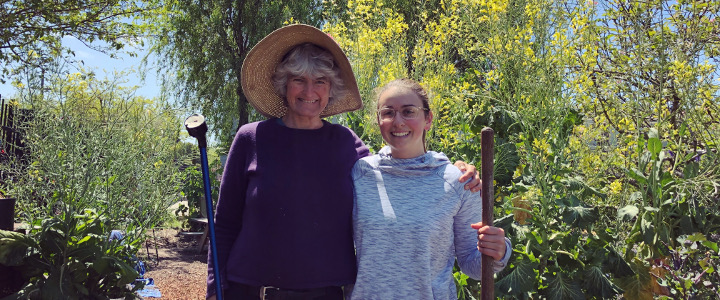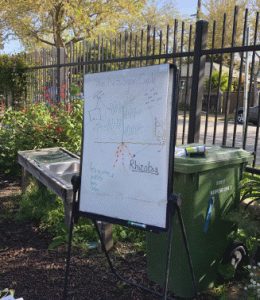Written by Hannah Spinner
Spring 2018
This semester I interned with Berkeley Unified School District at Malcolm X Elementary in the school garden. Everyday that I went into the garden, I got showered with children, plants, and food. The entire experience was so absolutely positive and I want to share one of my final days in the garden with you. One of my personal goals for this project was to effectively communicate complex science in a simple manner to young students. Upon discussing this with the garden teacher Rivka, she suggested that I design a lesson plan about leguminous nitrogen fixation. The third graders planted a crop of fava beans in the fall, so this felt like the perfect opportunity to connect with that experience and talk about soil health.

During the opening circle of my lesson, all of the students gathered together and talked about the general theme of this lesson. I asked them several questions to warm them up.
- “What do living things need to survive?” Their response was that living things need light, air, water, sun, food, nutrients, and habitats.
- “How do we as humans get our nutrients?” They said from the healthy food and plants we eat.
- “How do plants get their nutrients?” The students mentioned compost and soil and also making energy from the sun. I mentioned that a key nutrient that plants need is nitrogen. Most students had not heard of nitrogen before, so I drew up a simplified version of the nitrogen cycle on a big piece of paper and explained how nitrogen moves through ecosystems.

“How many of you have ever had a jar that you struggled opening? No matter how hard you twisted, the lid still wouldn’t come off?” All of the students raised their hands.
“And what did you do? Did you ask a friend or adult to come help open it with you?” And all of the students nodded.
“The nitrogen in the air is like the jar that’s really hard to open. It’s super tightly bound to itself and hard to crack open. The plant is like you struggling to open it on your own, but the bacteria are like the adult or friend that comes to help you. Because they are so strong and good at breaking apart the nitrogen, they allow you to access it in a different form.” This metaphor was really effective with the students and they were very receptive to it!
After talking about the rest of the nitrogen cycle, we split the students into two groups. One group went with Rivka to break down fava bean stalks and chop them into the soil. The other group stayed with me and took a closer look at the root nodules. I gave them all some fava bean roots and hand lenses. I let them have completely unsupervised learning for 5 minutes to explore the roots as much as possible. I also encouraged them to break the nodules open and look inside. I heard observations like “wow they are so pink!” “It looks like blood in there!” These comments opened up conversations about how similar some compounds in these nodules are to our own blood. I love getting off topic and indulging students’ curiosities!

All of the students have journals for observations and notes from the garden; during the last few minutes I asked them to write down the nitrogen cycle and draw the root nodules with any observations they made. After the entire class had done both activities, we came back together for a closing circle and shared observations and favorite facts from the lesson.
I was completely surprised and delighted at how engaged the students were throughout the entire lesson. Although it was unfamiliar territory for most of them, they rocked it! Later in the day during recess, one of the students came back to the garden to help out and get a snack. We were cutting down some plants and turning them into the soil as a green manure. Within seconds of showing him what we were doing, he exclaimed, “Oh, I get it! We’re returning nutrients to the soil! Just like you talked about in your lesson!” This was one of the most rewarding moments of the entire internship. This student was able to grasp the very advanced material that I presented and apply that knowledge several hours later. These children are phenomenal, inspirational, and passionate learners. It is clear that they love this garden and everything they learn here.
